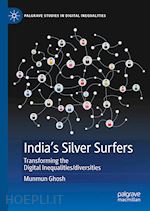
Questo prodotto usufruisce delle SPEDIZIONI GRATIS
selezionando l'opzione Corriere Veloce in fase di ordine.
Pagabile anche con Carta della cultura giovani e del merito, 18App Bonus Cultura e Carta del Docente
This book provides a thorough investigation of the potential and challenges of older individuals' digital disparities in the context of the digital era. A particular set of challenges prevent the ageing population from efficiently accessing and utilising digital resources as technology becomes more pervasive in contemporary culture. The multidimensional nature of digital disparities is clarified in this work. It explores how these discrepancies affect older people's quality of life, access to healthcare, social connections, and general well-being, taking India as a case study.
The book begins by thoroughly summarising demographic trends and changes in technology adoption caused by ageing. It looks at the variables that affect older individuals' propensity to use technology and the effects of their attitudes and perceptions about digital technologies around them. The author investigates the intricate web of access inequities older persons face in a quickly changing digital environment, from internet accessibility to the availability of appropriate digital content. The book also emphasises the need for digital literacy and skills to boost elders' technology involvement. It looks at their challenges when learning and using digital skills, especially in light of how quickly technology develops. The author also explores the effects of digital disparities on older people's physical and mental health, highlighting the demand for specialised therapies and support networks.
Preface. _Acknowledgement. -Chapter 1:Introduction .- 1.1.Context of Ageing or Old Age and Olders in India. -1.2.Quick Glimpse on the Digital Report of India.-1.3.Some Quick Facts on the Ageing Generation in India. -1.4.Need for Age-Centric Investigation in the Digital Age.-1.5.Significance of Addressing Age-Centric Digital Inequalities.-1.6.Digital Access and Policy Priorities.-1.7.Scope of this Book .-Chapter 2: Ageing and Technology.-2.1. Changing Demographics and an Ageing Population.-2.2. Motives Behind Older Adults' Adoption of Technology.-2.2.1. Technology's Imperceptible Hand.-2.2.2. Technology as a Privilege and Being Impressive.-2.2.3. Technology as a Curiosity.-2.2.4. Creating the Social Self with Technology .-2.2.5. Communication Assisted by Technology.-Chapter 3: The Digital Divide and the Older Adults.-3.1. Access & Usage Divide: Elderly Digital Access, Connectivity and Usage.-3.2. Attitudinal Divide: Understanding Elderly' Technology Resistance.-3.2.1. Changing Attitude of Olders towards technology post-COVID-19 pandemic.-3.3. Barriers to Digital Inclusion of the Ageing Population.-3.4. Benefits of Combating "Digital Divide".-Chapter 4: Digital-era of Well-being.-4.1. Digital Socialisation: Nurturing the Well-Being.-4.2. Digital Tools to Support the Mental Health of Older .-4.3. Digital Tools to Support the Physical Health of Older .-4.4. Age-Enhancing Assistive Technologies Optimising Well-being.-4.4.1. Details of Few Assistive Devices and Technologies for the Older in India.-Chapter 5: Ageless Bonds: Bridging Generations and Technology to Combat Ageism.-5.1. Addressing Ageism in Family and Society.-5.1.1. Examples of Ageism Being Expressed Within the Context of Families.-5.1.2. Combatting Ageism: A Crucial Aspect of Fostering Harmony.-5.2. The Digital Wave and Generational Divides.-5.2.1. Social Media Influence on Family Dynamics.-5.2.2. Challenges Faced by Older Family Members in Adapting to the Digital Era.-5.2.3. Navigating Generational Divides.-5.3. Family Ties and Intergenerational Bonds.-5.3.1. Family Ties and Intergenerational Dynamics in Rural India.-5.4. Preserving Tradition in the Digital Age.-5.5. Addressing Stereotypes and Promoting Inclusive Narrative.-5.5.1. Breaking Down Generational Silos.-5.5.2. Fostering Interconnectedness Shattering Stereotypes.-5.5.4. Altering the Portrayal of Ageing Stereotypes in Media and Performing Arts.-5.5.5. Generational Unity in Defying Age Stereotypes.-Chapter 6: Privacy and Security Issues Elderly Face Online.-6.1. Older Adults' Digital Privacy Risks and Challenges.-6.2. Digital Literacy for the Seniors .-6.3. Digital Identity and Digital Identity Protection .-Chapter 7: Policy Implementations in India to Assist the Elderly.-7.1. Policies to Support Olders in India .-7.2. Programmes and Initiatives from Other Central Ministries concerning Olders
.-7.3. Additional Schemes to Support Older Post-Pandemic.-7.4. Scheme for the Digital Inclusion .-Chapter 8: Case Studies of Effective Age-Friendly Digital Initiatives.-8.1. Age-Friendly Cities and Communities as Guided by WHO.-8.2. Few Initiatives of Age-friendly Cities Globally.-8.3. India Towards Being an Age-friendly Community.-Chapter 9: Silver Surfers of India: The Beginning.-9.1. Recapitulation of the Book.-9.2. The Silver Surfers of India – A New Beginning.-Index.
Dr Munmun Ghosh is an Associate Professor at Symbiosis Institute of Media and Communication, Symbiosis International University, Pune, India. Her research interests involve integrating technology into society, most notably researching how people use digital media to configure themselves and their social relations.











Il sito utilizza cookie ed altri strumenti di tracciamento che raccolgono informazioni dal dispositivo dell’utente. Oltre ai cookie tecnici ed analitici aggregati, strettamente necessari per il funzionamento di questo sito web, previo consenso dell’utente possono essere installati cookie di profilazione e marketing e cookie dei social media. Cliccando su “Accetto tutti i cookie” saranno attivate tutte le categorie di cookie. Per accettare solo deterninate categorie di cookie, cliccare invece su “Impostazioni cookie”. Chiudendo il banner o continuando a navigare saranno installati solo cookie tecnici. Per maggiori dettagli, consultare la Cookie Policy.